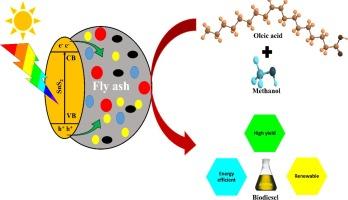利用新型 SnS2/Fly ash 光催化剂进行可见光驱动的光催化生物柴油生产
IF 6.7
1区 工程技术
Q2 ENERGY & FUELS
引用次数: 0
摘要
化石燃料的急剧枯竭促使人类探索石油产品的替代能源。生物柴油是石油柴油的绿色环保替代品,可用于柴油发动机。粉煤灰是火力发电厂燃煤时产生的过量粉状废物。科学家们一直在寻找新的方法来利用粉煤灰,实现 "变废为宝"。本研究阐明了一种具有开创性可见光活性的 SnS2/粉煤灰纳米复合材料的合成,强调了其在生物柴油生产中的光催化活性。油酸被用作测试底物,因为它通常存在于几种生物柴油原料中,如废大豆、废煎炸油和棕榈油。通过优化反应条件,在光照 50 分钟内,当光催化剂负载量为 3 wt%,甲醇与油酸的比例为 8:1 时,生物柴油产量最高,达到 99.89 ± 0.10 %,光照条件为 338 K。反应动力学符合伪一阶动力学模型,速率常数为 0.1488 min-1,油酸光催化酯化所需的活化能为 29.16 kJ/mol。清除试验表明,电子的激发是引发光催化反应的关键,并提出了酯化反应的机理。合成的 SFA 光催化剂非常稳定,可重复使用,在连续 5 个酯化循环中保持高效,生物柴油产率为 82.07 ± 1.12 %,表明 SFA 纳米复合材料有望取代现有的异相热催化剂用于生物柴油生产。本文章由计算机程序翻译,如有差异,请以英文原文为准。

Visible light-driven photocatalytic biodiesel production using novel SnS2/Fly ash photocatalyst
The exponential depletion of fossil fuels urges humankind to explore alternative energy sources for petroleum products. Biodiesel is a greener and environmentally friendly alternative to petroleum diesel and could be used in diesel engines. Fly ash is powdery waste produced in overabundance by coal combustion in thermal power plants. Scientists are continuously searching for ways to provide a new dimension to the utilization of fly ash for creating “Best out of Waste”. The current study elucidates the synthesis of a pioneering visible light active SnS2/Fly ash nanocomposite, emphasizing its photocatalytic activity in biodiesel production. Oleic acid was used as the test substrate since it is often found in several biodiesel feedstocks, such as waste soybean, waste frying, and palm oil. The optimization of the reaction conditions gives the highest biodiesel yield of 99.89 ± 0.10 % at photocatalyst loading of 3 wt%, methanol-to-oleic acid ratio of 8:1 at 338 K within 50 min light exposure. The reaction kinetics were observed to conform to a pseudo-first-order kinetic model, characterized by a rate constant of 0.1488 min−1, and the activation energy necessary for the photocatalytic esterification of oleic acid was 29.16 kJ/mol. The scavenging tests suggested that the excitation of electrons is crucial to initiate the photocatalytic reaction, and the mechanism of the esterification reaction was proposed. The synthesized SFA photocatalyst was very stable and reusable, maintaining efficiency across five successive esterification cycles with a biodiesel yield of 82.07 ± 1.12 %, indicating the potential of SFA nanocomposite to replace existing heterogeneous thermal catalysts for biodiesel production.
求助全文
通过发布文献求助,成功后即可免费获取论文全文。
去求助
来源期刊

Fuel
工程技术-工程:化工
CiteScore
12.80
自引率
20.30%
发文量
3506
审稿时长
64 days
期刊介绍:
The exploration of energy sources remains a critical matter of study. For the past nine decades, fuel has consistently held the forefront in primary research efforts within the field of energy science. This area of investigation encompasses a wide range of subjects, with a particular emphasis on emerging concerns like environmental factors and pollution.
 求助内容:
求助内容: 应助结果提醒方式:
应助结果提醒方式:


